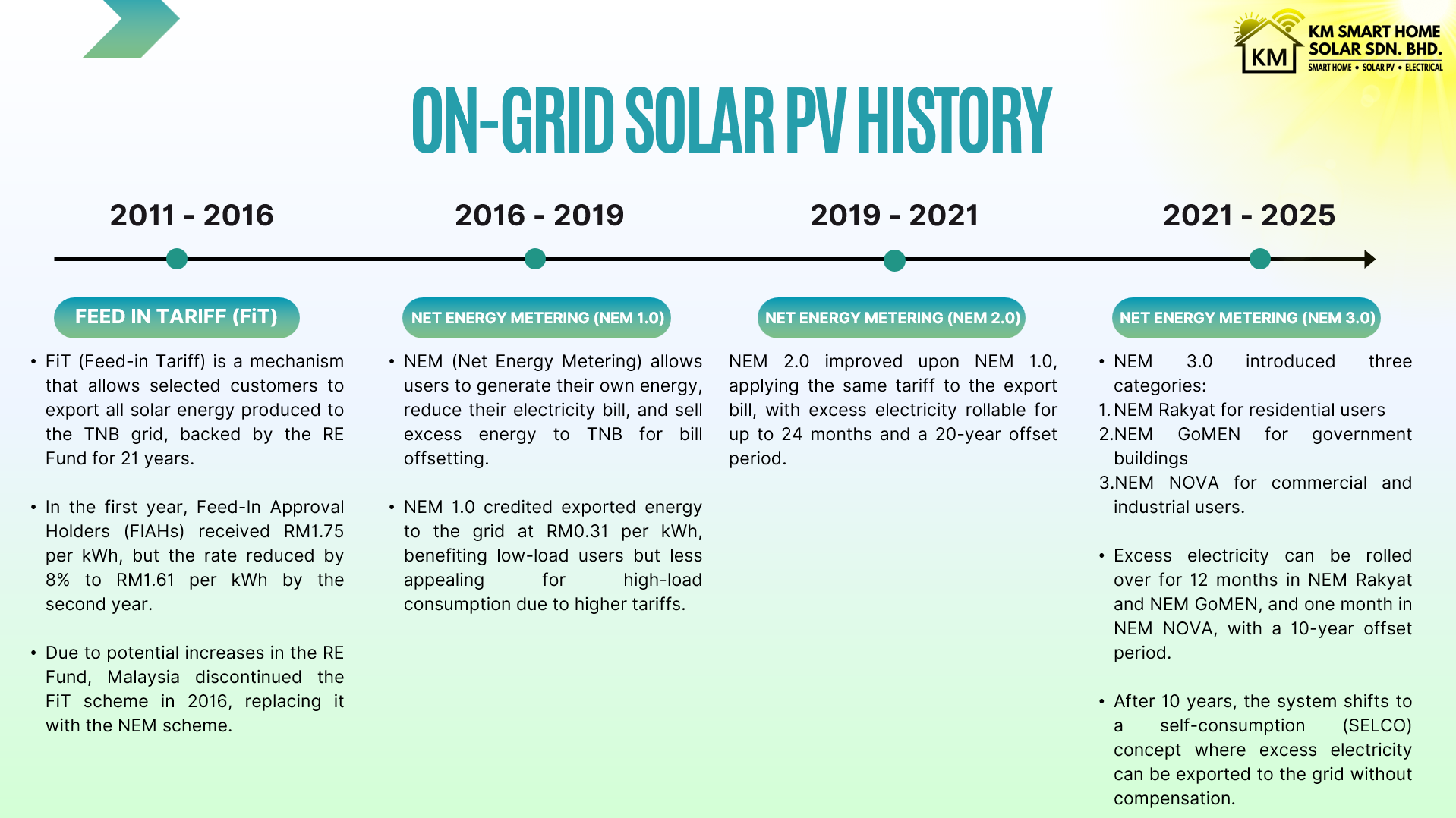
WHAT IS NET ENERGY METERING (NEM)?
Net Energy Metering (NEM) is a program introduced in Malaysia to promote renewable energy, particularly solar power, by allowing consumers to generate their own electricity and reduce their electricity bills. NEM provides a financial incentive for consumers to install solar photovoltaic (PV) systems, enabling them to generate clean energy while staying connected to the national grid. The program supports Malaysia’s vision for sustainable energy use and helps the country achieve its renewable energy goals.
What is Net Energy Metering?
In simple terms, Net Energy Metering allows consumers with solar PV systems to generate electricity and offset their energy bills by selling excess power back to the national grid. When a household or business generates more electricity than it consumes, the surplus energy is exported to the grid, and in return, the consumer earns credit or compensation, reducing their overall energy costs. Conversely, when the solar panels do not produce enough power (such as during cloudy weather or at night), the consumer can draw electricity from the grid.
Key Features of Malaysia’s NEM Program
1. Credit-Based System: Under NEM, the amount of surplus energy exported to the grid is credited to the consumer’s account. This credit is used to offset the cost of electricity drawn from the grid, allowing consumers to reduce their energy expenses significantly.
2. One-to-One Offset Mechanism: Malaysia's NEM 3.0 program, which came into effect in 2021, introduced a one-to-one offset rate. This means that for every kilowatt-hour (kWh) exported to the grid, consumers receive the same value of credit that they would pay if they consumed one kWh from the grid. This policy provides greater financial benefits to consumers and makes NEM more attractive for residential, commercial, and industrial users.
3. Program Categories: NEM 3.0 offers several categories tailored to different user needs:
- NEM Rakyat: Targeted at residential users, NEM Rakyat provides access to the one-to-one offset mechanism, helping households reduce their electricity bills and adopt solar energy affordably.
- NEM GoMEn: Short for “Government Ministries and Entities,” this category is tailored for government buildings and entities to support the government’s sustainability goals.
- NEM NOVA: NOVA (Net Offset Virtual Aggregation) is designed for commercial and industrial entities, allowing them to generate and offset electricity usage through aggregated NEM credits, even across multiple facilities.
4. No Excess Payment: Unlike some NEM programs worldwide, Malaysia’s NEM does not compensate consumers for extra energy at the end of the year. Any unused credits are forfeited, encouraging consumers to size their PV systems according to their own energy needs.
Benefits of NEM for Malaysia
The NEM program aligns well with Malaysia’s goal of achieving 31% renewable energy capacity by 2025 and 40% by 2035. Here are some key benefits:
- Cost Savings: NEM enables significant energy cost reductions for participants, especially for those with high electricity usage. The one-to-one offset rate in NEM 3.0 offers financial viability for installing solar systems.
- Environmental Impact: By encouraging the adoption of solar energy, NEM contributes to reducing Malaysia’s carbon emissions and reliance on fossil fuels.
- Energy Security: A decentralized grid with more renewable energy sources improves Malaysia’s energy security and reduces dependence on imported energy.
How to Participate in NEM
To participate in NEM, consumers need to install a solar PV system, which can be done through licensed service providers. The system size and setup should match the consumer's energy consumption needs for optimal efficiency. The application process for NEM can be completed through the Sustainable Energy Development Authority (SEDA) Malaysia, which manages the program and ensures regulatory compliance.
Challenges and Future Outlook
While NEM provides numerous benefits, challenges remain, including high initial installation costs, regulatory complexities, and public awareness. However, with government support, continuous improvements, and increasing demand for renewable energy, NEM is set to play a vital role in Malaysia’s sustainable energy landscape.
Conclusion
Net Energy Metering (NEM) in Malaysia represents a powerful step towards a more sustainable and cost-effective energy future. By allowing consumers to generate their own energy and benefit from the one-to-one offset policy, Malaysia’s NEM program makes solar energy an attractive option for households, businesses, and government entities alike. Through this program, Malaysia not only advances its renewable energy goals but also moves closer to a greener and more resilient energy grid.